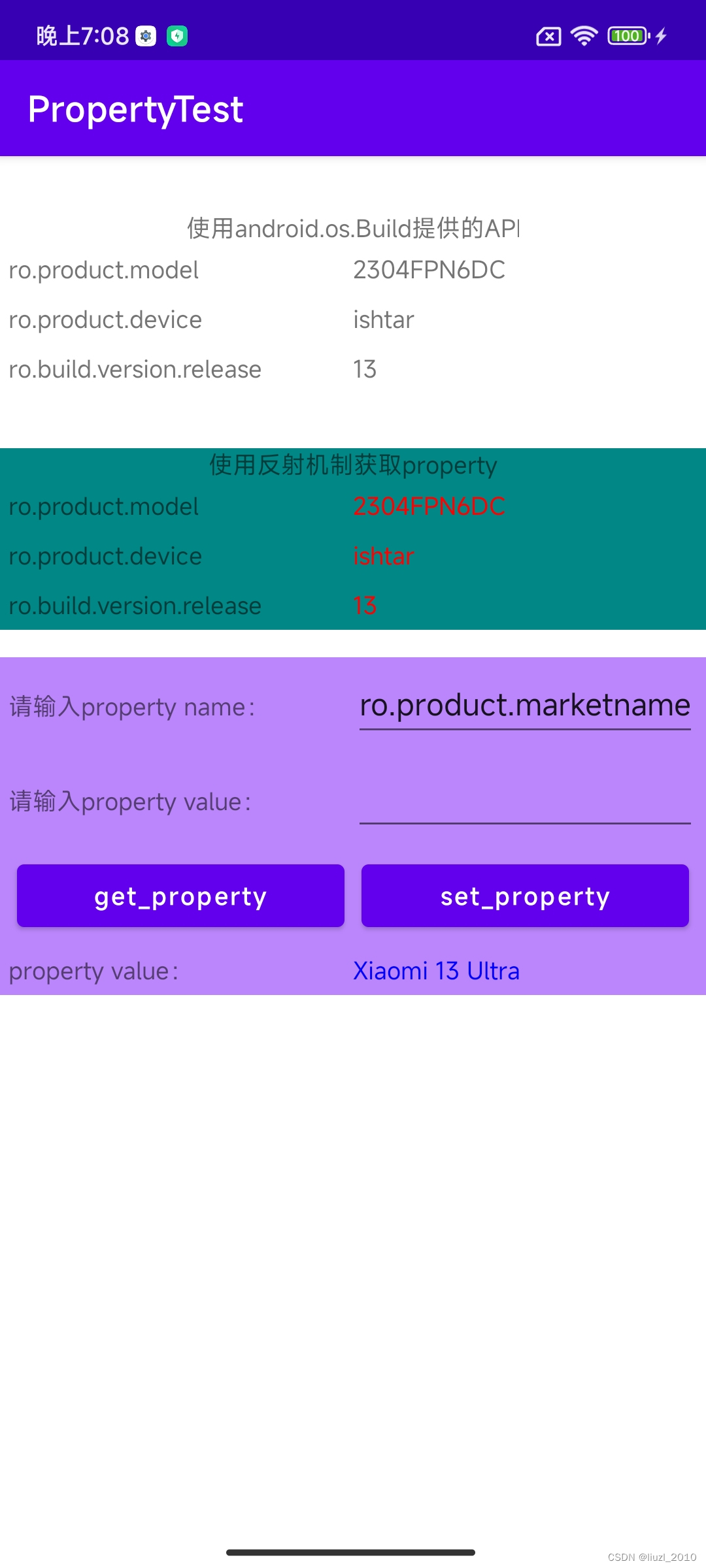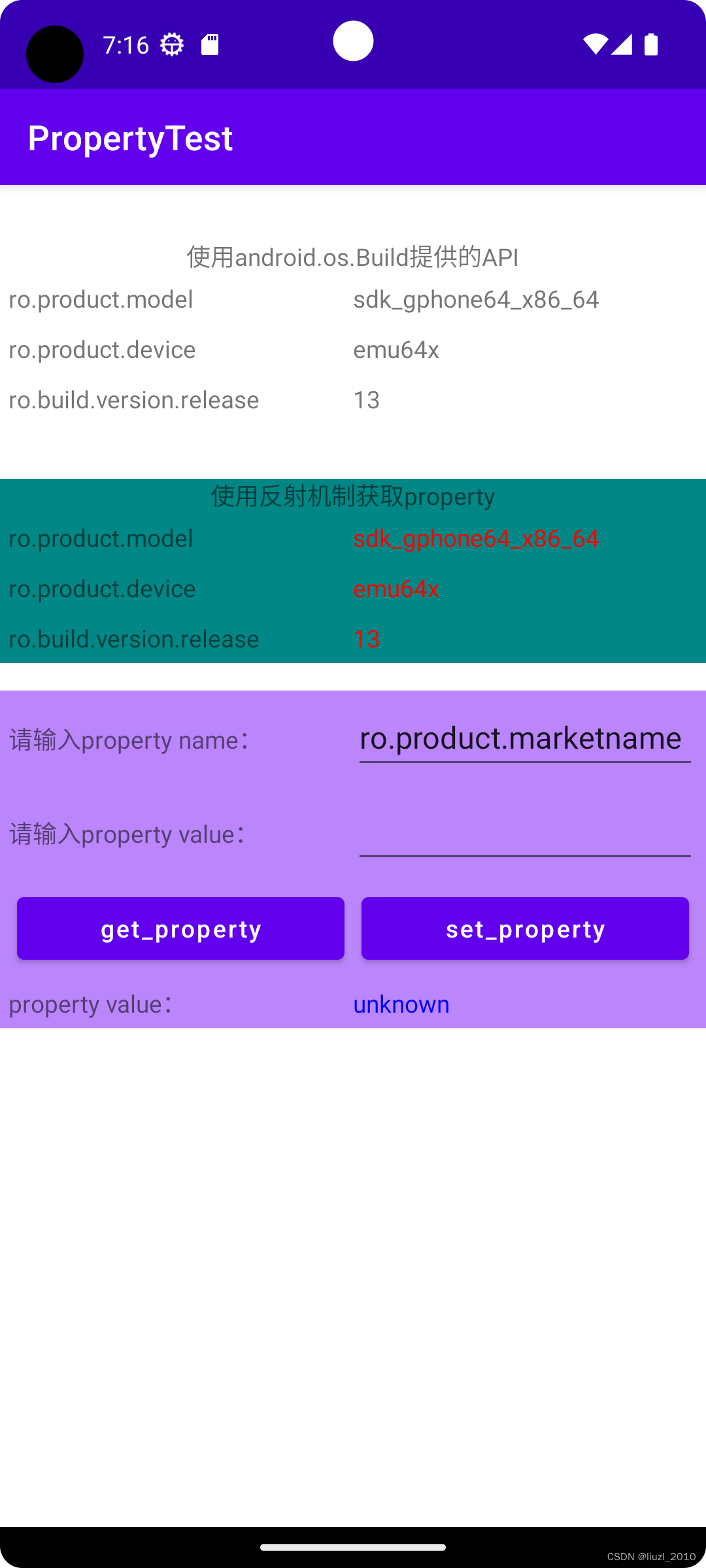开发过程中我们经常需要获取Property系统属性,比如model、device、product 等等,通常debug的时候可以使用如下命令获取。
adb shell getprop <property name>
adb shell setprop <property name> <property value>但是一个android 应用程序中需要获取系统的属性,该怎么获取呢?
通常有就如下几种方法:
- 使用android.os.Build提供的API,所有应用皆可使用,但是能获取的property非常有限
- 使用android.os.SystemProperties提供的API,但仅系统app可用
- 使用反射机制获取property,所有第三方app都可以使用
一、使用android.os.Build提供的API
frameworks/base/core/java/android/os/Build.java
public class Build {
private static final String TAG = "Build";
/** Value used for when a build property is unknown. */
public static final String UNKNOWN = "unknown";
/** Either a changelist number, or a label like "M4-rc20". */
public static final String ID = getString("ro.build.id");
/** A build ID string meant for displaying to the user */
public static final String DISPLAY = getString("ro.build.display.id");
/** The name of the overall product. */
public static final String PRODUCT = getString("ro.product.name");
/** The name of the industrial design. */
public static final String DEVICE = getString("ro.product.device");
/** The name of the underlying board, like "goldfish". */
public static final String BOARD = getString("ro.product.board");
/** The manufacturer of the product/hardware. */
public static final String MANUFACTURER = getString("ro.product.manufacturer");
/** The consumer-visible brand with which the product/hardware will be associated, if any. */
public static final String BRAND = getString("ro.product.brand");
/** The end-user-visible name for the end product. */
public static final String MODEL = getString("ro.product.model");
/** The manufacturer of the device's primary system-on-chip. */
@NonNull
public static final String SOC_MANUFACTURER = SocProperties.soc_manufacturer().orElse(UNKNOWN);
/** The model name of the device's primary system-on-chip. */
@NonNull
public static final String SOC_MODEL = SocProperties.soc_model().orElse(UNKNOWN);
/** The system bootloader version number. */
public static final String BOOTLOADER = getString("ro.bootloader");
...
/** Various version strings. */
public static class VERSION {
/**
* The internal value used by the underlying source control to
* represent this build. E.g., a perforce changelist number
* or a git hash.
*/
public static final String INCREMENTAL = getString("ro.build.version.incremental");
/**
* The user-visible version string. E.g., "1.0" or "3.4b5" or "bananas".
*
* This field is an opaque string. Do not assume that its value
* has any particular structure or that values of RELEASE from
* different releases can be somehow ordered.
*/
public static final String RELEASE = getString("ro.build.version.release");
...
public static final String SDK = getString("ro.build.version.sdk");
public static final int SDK_INT = SystemProperties.getInt(
"ro.build.version.sdk", 0);
...
}
@UnsupportedAppUsage
private static String getString(String property) {
return SystemProperties.get(property, UNKNOWN);
}
private static String[] getStringList(String property, String separator) {
String value = SystemProperties.get(property);
if (value.isEmpty()) {
return new String[0];
} else {
return value.split(separator);
}
}
@UnsupportedAppUsage
private static long getLong(String property) {
try {
return Long.parseLong(SystemProperties.get(property));
} catch (NumberFormatException e) {
return -1;
}
}
API在应用程序中使用非常简单:
// 1. import
import android.os.Build;
// 2. 直接使用
Log.d(TAG, "Build.PRODUCT: " + Build.PRODUCT);
Log.d(TAG, "Build.MODEL: " + Build.MODEL);
Log.d(TAG, "Build.SOC_MODEL: " + Build.SOC_MODEL);
Log.d(TAG, "Build.MANUFACTURER: " + Build.MANUFACTURER);
// Android 4.4W (KitKat Wear)系统及以上
if (Build.VERSION.SDK_INT >= 20) {
do something
} else {
do something
}如我使用xiaomi 13 Ultra,打印如下:
D/lzl-test: Build.PRODUCT: ishtar
D/lzl-test: Build.MODEL: 2304FPN6DC
D/lzl-test: Build.SOC_MODEL: SM8550
D/lzl-test: Build.MANUFACTURER: Xiaomi
二、使用android.os.SystemProperties提供的API
frameworks/base/core/java/android/os/SystemProperties.java
public class SystemProperties {
private static final String TAG = "SystemProperties";
@NonNull
@SystemApi
public static String get(@NonNull String key, @Nullable String def) {
if (TRACK_KEY_ACCESS) onKeyAccess(key);
return native_get(key, def);
}
@SystemApi
public static int getInt(@NonNull String key, int def) {
if (TRACK_KEY_ACCESS) onKeyAccess(key);
return native_get_int(key, def);
}
@SystemApi
public static boolean getBoolean(@NonNull String key, boolean def) {
if (TRACK_KEY_ACCESS) onKeyAccess(key);
return native_get_boolean(key, def);
}
...使用非常简单,但API只有系统应用才有权限,第三方应用请使用第三种方法。
三、使用反射机制获取property
public static String getProperty(String key, String defaultValue) {
String value = defaultValue;
try {
Class<?> c = Class.forName("android.os.SystemProperties");
Method get = c.getMethod("get", String.class, String.class);
value = (String) (get.invoke(c, key, "unknown"));
} catch (Exception e) {
e.printStackTrace();
} finally {
return value;
}
}
public static int setProperty(String key, String value) {
try {
Class<?> c = Class.forName("android.os.SystemProperties");
Method set = c.getMethod("set", String.class, String.class);
set.invoke(c, key, value);
return 0;
} catch (Exception e) {
e.printStackTrace();
return -1;
}
}四、测试程序
源码
百度网盘链接:百度网盘 请输入提取码 提取码:test
github下载地址:
GitHub - liuzhengliang1102/AndroidStudio-LearnAppDevelopment
PropertyTest目录
运行
左边:使用xiaomi 13 Ultra运行截图,右边:使用Pixel 6 API 33 模拟器运行截图







 文章介绍了在Android应用开发中获取系统属性的三种方式:通过android.os.Build类获取有限的属性信息,使用android.os.SystemPropertiesAPI(仅限系统应用),以及第三方应用通过反射调用SystemProperties获取属性。示例代码展示了如何在实践中运用这些方法。
文章介绍了在Android应用开发中获取系统属性的三种方式:通过android.os.Build类获取有限的属性信息,使用android.os.SystemPropertiesAPI(仅限系统应用),以及第三方应用通过反射调用SystemProperties获取属性。示例代码展示了如何在实践中运用这些方法。

















 241
241

 被折叠的 条评论
为什么被折叠?
被折叠的 条评论
为什么被折叠?










